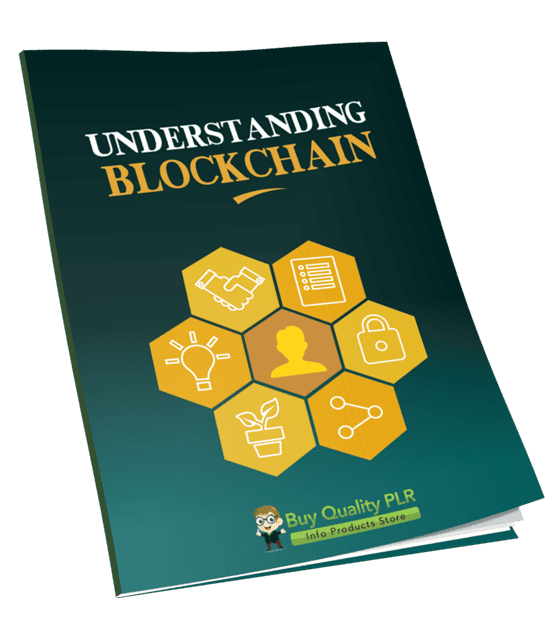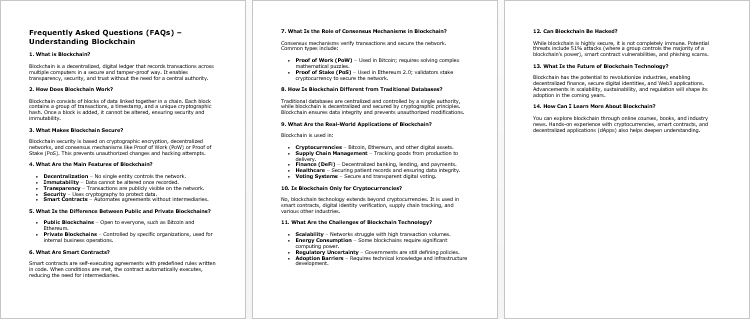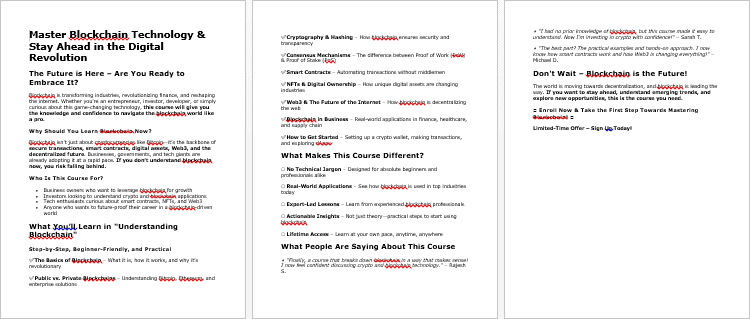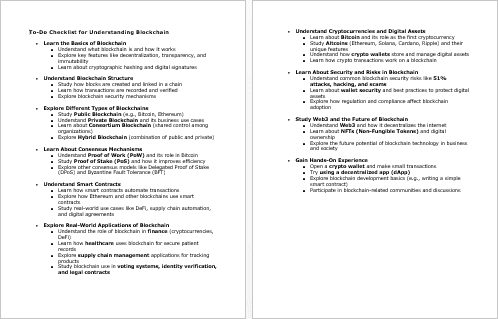
Understanding Blockchain PLR Course 19k Words
in Bitcoin , Bitcoin PLR , Bitcoin PLR Ebooks , Cryptocurrency PLR , Cryptocurrency PLR eBooks , PLR Checklists , PLR eBooks , PLR eCourses , PLR List Building Reports , Premium PLR , Premium PLR eBooks , Premium PLR Reports , Premium White Label Brandable PLR Coaching Courses , Private Label Rights ProductsChoose Your Desired Option(s)
has been added to your cart!
have been added to your cart!
#blockchainbasics #cryptoeducation #fintechmarketing #plrcourse #techtrends #financemarketing #blockchaintraining
Understanding Blockchain PLR Course – The Beginner’s Blueprint to Blockchain Technology
Simplify Blockchain for Beginners — and Profit from One of the Hottest Topics in Tech!
Blockchain technology is revolutionizing industries from finance and healthcare to logistics and digital identity. But here’s the problem — most people don’t understand how it works.
That’s where your new Understanding Blockchain PLR Course comes in.
This ready-to-sell Private Label Rights (PLR) course breaks down blockchain into simple, easy-to-follow lessons — helping your audience understand how it works, why it matters, and how it’s shaping the future of technology and business.
With over 23,000 words of expertly written content, this done-for-you course helps you position yourself as an authority in a booming niche — even if you’re not a tech expert.
You can rebrand, resell, or repurpose this course as your own — turning it into a profitable online course, eBook, membership program, or training resource!
Presenting…
Understanding Blockchain PLR Course 19k Words
Why the Blockchain Niche is Profitable Right Now
Blockchain isn’t just about cryptocurrency anymore.
It’s the foundation for Web3, decentralized finance (DeFi), smart contracts, NFTs, and more.
People are eager to understand blockchain for:
- Career advancement in tech and finance
- Investment opportunities in crypto and digital assets
- Business transformation and innovation
- Personal interest in the future of money and the internet
This course gives you everything you need to tap into this explosive growth market — with quality educational content written for beginners and non-technical audiences.
Course Overview
The Understanding Blockchain PLR Course is structured into five modules with clear, conversational lessons that demystify the complex world of blockchain technology.
Each module builds on the previous one — taking learners from basic concepts to real-world applications and future trends.
Module 1: Blockchain Basics – What It Is and Why It Matters
Start with the fundamentals. In this module, students learn what blockchain is, how it works, and why it’s so revolutionary.
- Step 1: What is Blockchain?
A simple explanation of blockchain as a digital ledger system — decentralized, secure, and transparent. - Step 2: How Does Blockchain Work?
Break down how transactions are recorded, validated, and stored in blocks that connect to form a secure chain. - Step 3: Key Features of Blockchain
Highlight the core principles: decentralization, immutability, and transparency. - Step 4: Why Blockchain Matters
Show real-world reasons why blockchain is changing how we handle money, data, and business processes.
This module gives learners a clear, jargon-free introduction — perfect for beginners who want to finally “get” blockchain.
Module 2: The Building Blocks of Blockchain Technology
In this module, learners discover how blockchain actually functions under the hood.
- Step 1: Blocks, Nodes, and Chains
Learn how data is structured, distributed, and secured across the network. - Step 2: Cryptography & Hashing
Understand how cryptography keeps information private and tamper-proof through unique digital fingerprints. - Step 3: Consensus Mechanisms – How Transactions Get Approved
Explore how blockchain networks agree on what’s valid using methods like Proof of Work (PoW) and Proof of Stake (PoS). - Step 4: Smart Contracts – Automating Transactions
Introduce smart contracts — self-executing code that automates payments, tasks, and agreements.
This module connects the dots between theory and functionality — showing how blockchain achieves trust without middlemen.
Module 3: Different Types of Blockchains & Their Uses
Not all blockchains are the same. Here, learners explore the various models and their unique use cases.
- Step 1: Public Blockchains (Open to Everyone)
Explain how open networks like Bitcoin and Ethereum operate transparently and securely. - Step 2: Private Blockchains (Controlled Access)
Used by corporations and banks for data privacy and compliance. - Step 3: Consortium & Hybrid Blockchains
Show how organizations collaborate through shared blockchain infrastructures for maximum efficiency. - Step 4: Real-World Blockchain Applications
Explore real-life examples in finance, healthcare, logistics, and beyond.
By the end of this module, students understand how different blockchain structures serve different purposes — and how they’re already being used globally.
Module 4: Cryptocurrencies & How They Work
This module dives into digital currencies — the most popular use case of blockchain.
- Step 1: What is Cryptocurrency?
Define cryptocurrencies as decentralized digital assets built on blockchain technology. - Step 2: Bitcoin vs. Altcoins (Ethereum, Ripple, etc.)
Explore the difference between Bitcoin and alternative coins that drive innovation in smart contracts and decentralized finance. - Step 3: How Do Crypto Transactions Work?
Teach how crypto wallets, miners, and validators ensure secure, peer-to-peer transactions. - Step 4: Crypto Security & Risks
Cover essential security practices — wallets, keys, and risk management to avoid scams and hacks.
This module is essential for anyone curious about how cryptocurrencies really function — without the hype.
Module 5: The Future of Blockchain – Trends & Innovations
End the course with an inspiring look at where blockchain is heading next.
- Step 1: Blockchain in Business & Industries
Explain how Fortune 500 companies use blockchain for supply chains, banking, and security. - Step 2: NFTs (Non-Fungible Tokens)
Introduce NFTs and how they’re redefining ownership for art, music, and digital assets. - Step 3: Web3 – The Next Internet Revolution
Show how blockchain is driving the decentralized internet where users own their data. - Step 4: The Challenges & Future Potential
Address key challenges like scalability and regulation, while emphasizing blockchain’s global potential.
This module inspires learners to think beyond crypto — showing how blockchain will reshape industries and economies.
What’s Included in the PLR Package
When you purchase the Understanding Blockchain PLR Course, you get everything you need to sell, teach, or repurpose the content immediately:
- Main Course Content (23,000+ Words)
Five full modules with 20 easy-to-follow lessons in friendly, conversational English. - Blockchain Checklist (600+ Words)
A quick-reference tool summarizing key takeaways from each module. - FAQs (900+ Words)
Answers to common questions about blockchain, crypto, and smart contracts. - Sales Page Copy (800+ Words)
A done-for-you professional sales page — ready to upload and start selling instantly.
Why This PLR Course is Perfect for You
This PLR course gives you a ready-made digital product that you can start monetizing today.
Whether you’re in the tech, finance, entrepreneurship, or education niche — blockchain is a hot topic that can expand your audience and grow your income.
Here’s what makes this PLR package stand out:
✅ Beginner-Friendly Content:
Explains complex concepts in plain language — no tech jargon required.
✅ Evergreen & Trending Topic:
Blockchain is still in its growth phase, and public curiosity keeps increasing.
✅ Fully Editable & Brandable:
Rebrand, rewrite, or merge with other courses to create your own signature product.
✅ High Perceived Value:
Blockchain training is being sold for hundreds of dollars — you can offer affordable access while profiting easily.
✅ Perfect for Multiple Formats:
Turn it into an eBook, video course, lead magnet, or training program.
How You Can Profit from This Course
This high-quality PLR course offers countless ways to make money and grow your brand:
- Sell It as a Digital Course
Upload to platforms like Teachable, Udemy, or Kajabi and sell access for $47–$97. - Break It Into Mini Courses or Reports
Sell individual modules as separate reports for $10–$20 each. - Bundle It With Other Tech or Finance PLR Products
Create a full “Crypto and Blockchain Masterclass” bundle to sell for $97–$197. - Use It as Content for a Membership Site
Deliver one module per week to paying subscribers. - Turn It Into a Video or Audio Course
Record it as a video training series to increase perceived value and sales. - Build Your Email List with Free Excerpts
Use module summaries or checklists as lead magnets to attract subscribers. - Flip It for Profit
Rebrand and sell the complete course or site as a done-for-you business.
License Terms
You CAN:
- Edit, rebrand, and sell as your own course.
- Convert to audio, video, or other multimedia.
- Add to a paid membership or training site.
- Use parts as lead magnets or promotional content.
You CANNOT:
- Give away or resell PLR rights.
- Distribute the full course for free.
- Offer 100% affiliate commissions (max 75%).
Start Teaching Blockchain and Profit Today!
The Understanding Blockchain PLR Course gives you a complete, ready-to-sell product in one of the world’s most in-demand niches.
You’ll educate your audience, build authority in the blockchain space, and generate consistent income — without spending months creating content.
✅ Comprehensive 23,000-word training course
✅ Editable, brandable, and ready to sell
✅ Includes checklist, FAQs, and sales page copy
✅ Evergreen topic with huge growth potential
Get your copy today and start selling your own Blockchain Training Course within hours! 🚀
has been added to your cart!
have been added to your cart!
Here A Sample of Understanding Blockchain PLR Course
Welcome to this exciting course on Blockchain Technology! Whether you’re a beginner or have some knowledge, this course will break down everything you need to know about blockchain in a simple, easy-to-follow way.
We’ll go through five modules, each with four clear steps, so by the end, you’ll feel confident in your understanding of blockchain and its real-world applications.
Module 1: Blockchain Basics – What It Is and Why It Matters
Before we dive deep, let’s start with the basics!
Step 1: What is Blockchain?
Blockchain is a revolutionary technology that acts as a digital ledger, recording transactions in a secure, transparent, and decentralized manner. Unlike traditional databases controlled by a single entity, blockchain is distributed across multiple computers, ensuring that no single party has control over the entire system. This structure makes it highly resistant to fraud, manipulation, and unauthorized modifications.
To understand blockchain in simple terms, imagine a notebook where every transaction or piece of data is recorded in permanent ink. Each page represents a block of data, and once a page is filled, it is sealed and linked to the previous page, forming a continuous chain of records. This structure is why it is called a blockchain.
Each block contains three main components:
- Data – This can be any type of information, such as financial transactions, digital contracts, or supply chain records.
- Hash – A unique digital fingerprint that identifies the block and its contents.
- Previous Block’s Hash – This links the current block to the one before it, ensuring a secure and unbroken chain.
Because every block is connected to the previous one, altering any information in a block would require changing all the subsequent blocks, which is nearly impossible due to the decentralized nature of the system. This feature makes blockchain tamper-proof and highly trustworthy.
Another important aspect of blockchain is its distributed nature. Instead of storing data in a central location like a bank’s database, blockchain operates on a peer-to-peer network, where multiple computers (called nodes) maintain copies of the ledger. Each node verifies and updates transactions, ensuring that the information remains accurate and consistent across the entire network.
Decentralization removes the need for intermediaries like banks, governments, or corporations to validate transactions. Instead, transactions are confirmed by a consensus mechanism, where multiple nodes agree on the accuracy of the data before adding it to the blockchain. This reduces fraud, hacking risks, and operational costs, making blockchain an efficient solution for industries ranging from finance to healthcare and supply chain management.
Blockchain’s security is further enhanced through cryptography, which ensures that all stored data is encrypted and protected from unauthorized access. This means that once a transaction is recorded, it cannot be deleted or altered without altering all subsequent records, which is practically impossible.
By functioning as a transparent and immutable digital ledger, blockchain provides a secure way to store and transfer valuable data without relying on a central authority. This has led to its adoption in various fields, including cryptocurrency, smart contracts, identity verification, and decentralized applications (DApps).
Understanding blockchain as a secure, decentralized, and tamper-proof system is the first step toward grasping its vast potential in transforming industries and redefining how digital transactions are conducted.
Step 2: How Does Blockchain Work?
To fully grasp how blockchain functions, imagine a digital record-keeping system where every transaction is carefully documented, verified, and stored in a way that prevents tampering or unauthorized changes. Blockchain operates as a decentralized network, meaning that instead of relying on a single central authority, multiple computers work together to maintain and validate the information. This structure ensures that all transactions are transparent, secure, and nearly impossible to alter once recorded.
The process of how blockchain works can be broken down into the following key steps:
1. A Transaction is Initiated
Whenever someone initiates a transaction on a blockchain network, the details of that transaction are broadcast to the network. A transaction could be anything from transferring cryptocurrency, signing a digital contract, verifying ownership of an asset, or recording supply chain data. Each transaction contains crucial details, such as the sender, the receiver, the amount, and a timestamp.
Unlike traditional systems where a central authority verifies transactions, blockchain relies on peer-to-peer verification, meaning multiple computers in the network must approve the transaction before it can be added to the blockchain.
2. The Transaction is Verified
Once the transaction is initiated, it must be verified before being recorded. This verification is performed by nodes, which are independent computers that participate in the blockchain network. Each node follows a set of rules to determine whether the transaction is valid.
The verification process depends on the specific type of blockchain being used. In public blockchains like Bitcoin and Ethereum, transactions are validated using a consensus mechanism such as Proof of Work (PoW) or Proof of Stake (PoS).
- In Proof of Work, miners use computational power to solve complex mathematical puzzles. The first miner to solve the puzzle gets the right to add the transaction to the blockchain and receives a reward.
- In Proof of Stake, validators are chosen based on the number of coins they hold and are willing to “stake” as collateral. The more coins they stake, the higher their chances of being selected to validate transactions.
This process ensures that only legitimate transactions are recorded, preventing fraud and double-spending.
3. The Verified Transaction is Added to a Block
After the transaction is verified, it is grouped with other approved transactions and added to a block. A block serves as a container that holds multiple transactions, similar to how a page in a ledger records multiple entries.
Each block contains:
- A list of verified transactions.
- A unique identifier called a hash, which serves as a fingerprint for the block.
- The hash of the previous block, linking it to the chain.
The inclusion of the previous block’s hash is what creates the chain in blockchain, ensuring that each block is permanently connected to the one before it.
4. The Block is Added to the Blockchain
Once a block is complete, it is added to the existing chain of blocks, forming a continuous, unalterable ledger. This chain of blocks is then distributed across all the nodes in the network, ensuring that everyone has an updated copy of the blockchain.
Since the blockchain is decentralized and stored on multiple computers, altering any information in a single block would require changing every copy of the blockchain stored across the network. This is practically impossible because it would require immense computational power and agreement from the majority of the network participants.
This decentralized structure makes blockchain highly secure and resistant to tampering. Any attempt to alter a transaction would be immediately detected, as every node in the network would compare its version of the blockchain with others and reject any inconsistencies.
Why is Blockchain Secure and Transparent?
Blockchain’s security and transparency come from its distributed nature and cryptographic protection. Since every transaction is stored across multiple computers, there is no single point of failure. Even if one computer fails, the network continues to function.
Additionally, each transaction is encrypted, and blocks are linked together using cryptographic hashes. This ensures that once a block is added, it cannot be altered without changing every subsequent block, which would require an unrealistic amount of computational effort.
Because blockchain records are open for verification by anyone within the network, the system remains transparent and trustworthy. This is why blockchain is being adopted in industries such as finance, healthcare, supply chain management, and digital identity verification—where security and transparency are critical.
By understanding how blockchain works step by step, it becomes clear why it is considered one of the most secure and efficient methods of storing and verifying digital information.
Step 3: Key Features of Blockchain
Blockchain technology is transforming the way data is stored, shared, and verified. Its unique characteristics make it one of the most secure, transparent, and efficient digital systems in the world. Unlike traditional centralized systems, blockchain operates on a decentralized network, ensuring that no single entity has complete control. Additionally, blockchain data is immutable, meaning that once a transaction is recorded, it cannot be altered or deleted. It also provides transparency, allowing anyone in the network to verify transactions in real-time.
Each of these key features plays a crucial role in the reliability and trustworthiness of blockchain. Understanding these core principles is essential for anyone looking to explore blockchain technology and its potential applications.
1. Decentralized – No Single Person or Company Controls It
One of the most defining characteristics of blockchain is its decentralization. Traditional systems, such as banking institutions and corporate databases, operate in a centralized manner. This means that a single authority, such as a bank, government, or organization, controls and manages the data. If the central authority is compromised, the entire system can fail, leading to potential data loss, fraud, or manipulation.
Blockchain eliminates the need for a central authority by distributing the data across a peer-to-peer network. Instead of storing information in one location, blockchain maintains a copy of the digital ledger on multiple computers, called nodes, spread across the network. Each node holds a copy of the blockchain and participates in verifying transactions, ensuring that the system remains operational even if some nodes go offline.
Decentralization provides several advantages, including:
- Eliminating single points of failure – No central server can be hacked or corrupted to compromise the entire system.
- Enhancing security – Since control is distributed among multiple participants, no single entity can manipulate the data.
- Providing uninterrupted service – The blockchain continues to function even if one or more nodes fail.
Because of its decentralized nature, blockchain is widely used in industries such as finance, healthcare, supply chain management, and identity verification, where trust and security are critical.
2. Immutable – Once Data is Added, It Cannot Be Changed
Another key feature of blockchain is immutability, meaning that once information is recorded on the blockchain, it cannot be altered or deleted. In traditional databases, data can be modified, erased, or manipulated by administrators or cyber attackers. This creates vulnerabilities that can lead to fraud, unauthorized changes, or loss of important records.
Blockchain prevents this by using a cryptographic hashing mechanism to secure each block of data. Every block in the chain contains:
- A unique hash (a digital fingerprint of the block’s data).
- The hash of the previous block, linking it to the chain.
If someone attempts to change the data in a previous block, the hash of that block will change, breaking the link to the next block and alerting the network to an attempted tampering. Because the blockchain is stored across multiple nodes, the network will reject any altered copies and maintain the original, untampered version.
The immutability of blockchain ensures:
- Data integrity – Transactions are permanently recorded and cannot be manipulated.
- Enhanced security – Fraud and cyber-attacks become nearly impossible due to cryptographic protection.
- Auditability – Every transaction has a clear history that can be easily verified by participants in the network.
Because of this feature, blockchain is widely used in industries where secure, tamper-proof records are essential, such as financial transactions, legal contracts, medical records, and government data management.
3. Transparent – Everyone in the Network Can Verify Transactions
Transparency is another core feature that makes blockchain highly trustworthy. In traditional financial systems, transaction details are often hidden from the public and managed by a centralized authority. This lack of transparency can lead to fraud, corruption, and a lack of accountability.
Blockchain, on the other hand, operates on a public ledger system, meaning that all transactions are recorded and made accessible to everyone in the network. While sensitive information can still be encrypted for privacy, the overall transaction history remains visible and verifiable.
Transparency is achieved through:
- Publicly accessible records – In open blockchain networks like Bitcoin and Ethereum, anyone can view transaction histories and track the movement of assets.
- Distributed verification – Every node in the network has a copy of the blockchain and can verify new transactions.
- Consensus mechanisms – Transactions are only added to the blockchain if the majority of participants agree on their validity.
The benefits of blockchain transparency include:
- Reducing fraud – Since transactions are visible and cannot be altered, it is difficult to engage in dishonest activities.
- Building trust – Users can independently verify transactions without needing to rely on intermediaries.
- Ensuring accountability – Organizations and businesses that use blockchain can provide transparent records of their operations, increasing trust with customers and stakeholders.
Because of its transparency, blockchain is widely used in areas such as supply chain management, charitable donations, election voting systems, and digital identity verification.
Conclusion
The key features of blockchain—decentralization, immutability, and transparency—make it one of the most innovative and secure technologies available today. By removing the need for intermediaries, ensuring data integrity, and allowing open verification of transactions, blockchain is transforming industries and creating new opportunities for secure and efficient digital transactions. Understanding these foundational features is crucial for anyone looking to leverage blockchain technology for business, finance, or digital security solutions.
Step 4: Why is Blockchain Important?
Blockchain technology is revolutionizing industries by offering a secure, transparent, and efficient way to store and transfer data. Its importance lies in its ability to eliminate the need for intermediaries, enhance security, and increase trust in digital transactions. Traditionally, transactions and data management relied on centralized entities such as banks, governments, and third-party service providers. However, these systems often come with inefficiencies, high costs, and security risks.
Blockchain removes many of these barriers by creating a decentralized, immutable, and transparent system that allows individuals and organizations to interact directly and securely. Because of its versatility, blockchain is being widely adopted across multiple industries, including finance, healthcare, supply chain management, and digital identity verification. Understanding its importance is key to recognizing its potential to transform global digital systems.
1. It Removes the Need for Middlemen (Like Banks)
One of the biggest advantages of blockchain technology is that it allows transactions to take place without the need for intermediaries. Traditionally, financial transactions, legal agreements, and data verification require the involvement of banks, brokers, or other centralized authorities to oversee and approve processes. These middlemen increase transaction costs, slow down processing times, and introduce points of failure where fraud or corruption can occur.
Blockchain removes the reliance on intermediaries by allowing individuals and businesses to directly exchange value or data in a peer-to-peer network. Transactions are recorded on a distributed ledger and verified by network participants using a consensus mechanism. This eliminates the need for trust in a third party because the system itself ensures accuracy and security.
The benefits of eliminating middlemen include:
- Lower transaction costs – No need to pay fees to banks or brokers.
- Faster processing times – Transactions are completed in minutes or seconds instead of days.
- Greater financial inclusion – People in regions without access to traditional banking can participate in the global economy.
- Reduced risk of fraud – Without centralized control, no single entity can manipulate transaction records.
Because of these benefits, blockchain is widely used in digital payments, international remittances, and smart contracts, where speed, cost efficiency, and security are crucial.
2. It Enhances Security, Trust, and Efficiency
Security is a major concern in digital transactions, as cyberattacks, data breaches, and fraud are common issues in centralized systems. Blockchain enhances security by using advanced cryptographic encryption, decentralized storage, and consensus mechanisms to protect data from unauthorized changes.
Here’s how blockchain enhances security:
- Data encryption – Every transaction is secured using cryptographic hashing, making it impossible to alter past records.
- Decentralization – Data is stored across multiple nodes, reducing the risk of hacking or server failure.
- Consensus mechanisms – Transactions must be approved by the network before being added to the blockchain, ensuring accuracy.
Trust is another key advantage of blockchain. Traditional systems often require users to place blind trust in institutions, whether it’s a bank managing their money or a government storing their personal data. Blockchain removes the need for trust in a central authority by allowing anyone to verify transactions themselves. This builds confidence in the system and reduces the risk of corruption or manipulation.
Efficiency is another crucial factor. Traditional financial and data systems are often slow, bureaucratic, and error-prone. Blockchain streamlines processes by automating transactions through smart contracts, reducing paperwork, and eliminating delays caused by human intervention.
The efficiency of blockchain is particularly valuable in industries where speed and accuracy are essential, such as cross-border payments, supply chain logistics, and digital asset trading.
3. Used in Various Industries Like Finance, Healthcare, and Supply Chains
Blockchain’s benefits extend beyond cryptocurrency and financial transactions. Its ability to provide secure, transparent, and tamper-proof data management has led to its adoption in many industries that require trust and efficiency.
- Finance and Banking – Blockchain enables fast, low-cost international transactions, secure digital payments, and decentralized finance (DeFi) solutions. Banks are using blockchain for fraud prevention, automated clearing systems, and improving transparency in financial records.
- Healthcare – Blockchain is used to securely store and share patient records, reducing medical errors and improving data privacy. It allows hospitals, clinics, and insurance companies to verify and access health information without the risk of data tampering.
- Supply Chain Management – Blockchain improves traceability and transparency by allowing businesses to track products from manufacturing to delivery. It prevents counterfeit goods, ensures ethical sourcing, and optimizes logistics.
- Real Estate – Blockchain is used for secure property transactions, digital land records, and smart contracts that eliminate the need for paperwork and reduce fraud.
- Government and Voting Systems – Governments are exploring blockchain for tamper-proof voting systems, secure identity verification, and transparent public records.
- Intellectual Property and Digital Rights – Blockchain helps protect music, art, and digital content by providing copyright verification and royalty tracking through digital tokens (NFTs).
The growing adoption of blockchain across industries proves its importance in creating a more secure, efficient, and decentralized digital future.
Conclusion
Blockchain technology is important because it solves critical problems in traditional systems, such as high costs, inefficiency, lack of trust, and security vulnerabilities. By eliminating middlemen, enhancing security, and being adopted in multiple industries, blockchain is shaping the future of digital transactions, business operations, and global financial systems. Understanding its significance allows individuals and businesses to explore new opportunities and harness the power of decentralization for a more efficient and trustworthy world.
We’re also giving these extra bonuses
Understanding Blockchain – Checklist
Understanding Blockchain – FAQs

Understanding Blockchain – Salespage Content

Package Details:
Word Count: 18 408 Words
Number of Pages: 83
Understanding Blockchain – Bonus Content
Checklist
Word Count: 383 words
FAQs
Word Count: 526 words
Salespage Content
Word Count: 468 words
Total Word Count: 19 785 Words
Your PLR License Terms
PERMISSIONS: What Can You Do With These Materials?
Sell the content basically as it is (with some minor tweaks to make it “yours”).
If you are going to claim copyright to anything created with this content, then you must substantially change at 75% of the content to distinguish yourself from other licensees.
Break up the content into small portions to sell as individual reports for $10-$20 each.
Bundle the content with other existing content to create larger products for $47-$97 each.
Setup your own membership site with the content and generate monthly residual payments!
Take the content and convert it into a multiple-week “eclass” that you charge $297-$497 to access!
Use the content to create a “physical” product that you sell for premium prices!
Convert it to audios, videos, membership site content and more.
Excerpt and / or edit portions of the content to give away for free as blog posts, reports, etc. to use as lead magnets, incentives and more!
Create your own original product from it, set it up at a site and “flip” the site for megabucks!
RESTRICTIONS: What Can’t You Do With These Materials?
To protect the value of these products, you may not pass on the rights to your customers. This means that your customers may not have PLR rights or reprint / resell rights passed on to them.
You may not pass on any kind of licensing (PLR, reprint / resell, etc.) to ANY offer created from ANY PORTION OF this content that would allow additional people to sell or give away any portion of the content contained in this package.
You may not offer 100% commission to affiliates selling your version / copy of this product. The maximum affiliate commission you may pay out for offers created that include parts of this content is 75%.
You are not permitted to give the complete materials away in their current state for free – they must be sold. They must be excerpted and / or edited to be given away, unless otherwise noted. Example: You ARE permitted to excerpt portions of content for blog posts, lead magnets, etc.
You may not add this content to any part of an existing customer order that would not require them to make an additional purchase. (IE You cannot add it to a package, membership site, etc. that customers have ALREADY paid for.)
Share Now!













